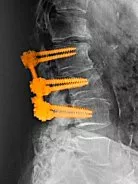Spinal Fusion is used by the Surgeons at the Southwest Scoliosis and Spine Institute
Spinal Fusion
The surgical procedure called Spinal fusion joins two or more vertebrae together to form a single structure. The purpose is to avoid back pain by stopping mobility between the two bones. They can’t move as they used to once they’ve fused. This prevents you from straining surrounding nerves, ligaments, and muscles, which might cause pain.
What can I do if I’m not sure if I need a Spinal Fusion?
The term “spinal fusion” conjures up images of a terrifying procedure. So, how can you know if this is the proper operation for you? I’m not sure what spinal fusion is or whether I need it. There are three basic criteria that answer this question.
- Scoliosis is a type of spine deformity that requires surgery to rectify.
- A spine that is weak or unstable: corrects instability caused by severe arthritis.
- After removing a damaged disc, a herniated disc restores spine stability.
While spinal fusion has been shown as an effective treatment for these three disorders, it has not been demonstrated in the treatment of non-specific back pain.
The Benefit of Spinal Fusion Surgery
 When two vertebrae become fused together, one solid bone forms rather than two. The pain associated with the mobility or instability of the two vertebrae gets relieved since they can no longer move independently. This surgery also stops the nerves around the vertebrae from stretching, which can help the patient feel better. Because only a little section of the spine becomes fused, spinal fusion surgery normally does not limit a patient’s range of motion upon full recovery.
When two vertebrae become fused together, one solid bone forms rather than two. The pain associated with the mobility or instability of the two vertebrae gets relieved since they can no longer move independently. This surgery also stops the nerves around the vertebrae from stretching, which can help the patient feel better. Because only a little section of the spine becomes fused, spinal fusion surgery normally does not limit a patient’s range of motion upon full recovery.
Questions and Answers
What is Spinal Fusion?
Spinal fusion is a surgical procedure performed to join two or more vertebrae together, creating a solid bridge between them. The procedure is typically done to stabilize the spine, alleviate pain, and improve spinal alignment. During the surgery, bone grafts, implants, or other materials are used to promote bone growth and fuse the vertebrae into a single, solid structure.
Why do doctors recommend Spinal Fusion?
Spinal fusion may be recommended for various reasons, including degenerative disc disease, spinal instability, herniated discs, spinal fractures, scoliosis, or other conditions that cause spinal instability or chronic pain. The procedure aims to reduce pain by immobilizing the affected segment of the spine, restoring stability, correcting deformities, and preventing further damage or progression of the underlying condition.
What is the recovery time after Spinal Fusion Surgery?
The recovery process following spinal fusion surgery can vary depending on several factors, including the individual’s overall health, the extent of the surgery, and the specific condition being treated. Generally, patients can expect to spend a few days in the hospital for initial recovery and pain management. Following discharge, they may need to wear a brace to provide support and restrict movement during the initial healing period. Physical therapy and rehabilitation are often recommended to help regain strength, mobility, and flexibility. Full recovery can take several months, and it is important to follow post-operative instructions, attend follow-up appointments, and engage in prescribed exercises to optimize healing and achieve the best outcome.
Why Are You Having This Surgery?
If medications, physical therapy, and other procedures (such as steroid injections) haven’t eased back pain, spinal fusion should. Doctors normally only prescribe treatment if they are certain about the source of the problem. If your back problem is caused by one of the following, spinal fusion may help.
- Degenerative disc disease (DDD) – Degeneration of the space between discs; sometimes the discs will rub together.
- Fragmentation (broken spinal bone).
- Scoliosis – The Spine curves from one side or both.
- Spinal stenosis – The narrowing of the spinal column.
- Spondylolisthesis – one of your vertebrae slips out of place onto the vertebra below it.
- Tumors or infections in the spine.
How to Prepare?
If you haven’t had any recent blood tests or spinal X-rays, you could have them the week before your operation. The doctors will discuss the specifics of your procedure with you and your healthcare team. If anything doesn’t make sense, don’t be hesitant to ask questions. Your surgeon wants you well informed about your procedure. In the days leading up to your operation, keep the following in mind:
- Arrive at the surgical center on time. You’ll require transportation to and from your destination.
- Make a list of the medications you may and cannot take in the days leading up to your surgery. Some medications, such as aspirin and other anti-inflammatory treatments, may be dangerous. Do not ever take medications without first consulting your physician.
- Before your treatment, find out if you can eat or drink anything.
- Prepare your house. Raised toilet seats, shower chairs, slip-on shoes, reaching, and other help will be required.
The Operation
Spinal Fusion is conducted in two areas:
There are two methods for spinal fusion.
- Anterior lumbar interbody fusion involves your surgeon entering your body through your stomach.
- Posterior fusion involves your surgeon entering your body from behind.
They transfer the muscles and tissues to the side to see your spine when they create the incision. The damaged or painful discs’ joint(s) get removed. To join the discs and restrict them from sliding, they might use screws, rods, or bone grafts from another area of your body. The hip or pelvis are the most common sites for bone grafts. A donor graft is a bone transplant from someone else. Instead, some clinicians inject bone morphogenetic protein (BMP) into the spine. It aids in bone development stimulation. Depending on the complexity of the procedure, it might take several hours.
What you can Expect During Spinal Fusion
Surgeons execute spinal fusions while you’re asleep, so you’re completely unaware of what’s going on. Various procedures for conducting spinal fusion surgery have been devised by surgeons. The procedure employed by the surgeon determines the position of the fused vertebrae, the cause for the fusion, and, in certain cases, your overall health and body form.
The Following are Included in an Operation:
Incision. The surgeon creates an incision in one of three places to obtain access to the vertebrae that will be fused: directly over your spine in your neck or back, on either side of your spine, or in your belly or throat to reach the spine from the front.
Bone graft preparation. Bone grafts that join two vertebrae together might originate from a bone bank or from your own body, generally your pelvis. If your own bone is utilized, the surgeon will create an incision above your pelvic bone, extract a little amount of it, and then close it.
Fusion. The surgeon implants the bone graft material between the vertebrae to firmly fuse them together. To keep the vertebrae together while the bone transplant cures, metal plates, screws, or rods may be utilized. Some surgeons employ synthetic material instead of bone transplants in certain circumstances. These synthetic chemicals aid to increase bone development and accelerate vertebral fusion.
Recovering From Spinal Fusion:
You’ll remain in the hospital for many days following surgery. How much time it takes depends on a lot of factors, including your overall fitness level and whether you have any underlying medical concerns. The vast majority of visitors stay for at least four days. You may go home sooner, or you may have to stay for approximately a week. You’ll be hooked up to machines that will monitor your heart and make sure your body remains healthy during this period. You’ll also see a lot of tubes:
- An IV – Insertion of a very small line into your arm to provide fluids, antibiotics, and pain relievers.
- Some patients receive pain medication through a back tube, called an epidural catheter.
- Another tube, sometimes known as a catheter, attaches to the area of your body where urine typically exits. For the first some days, you’ll have this so you don’t have to get up to use the restroom. You may find it unpleasant, or you may not notice it at all. However, you must remain motionless so that your back can recover.
Occupational and physical therapists will teach you how to get out of bed, into a chair, and walk again during your stay. You’ll undergo spinal X-rays before your doctor sends you home to ensure that the fusion is working well. In around ten days, you’ll go back to remove the sutures. Following that, you’ll make follow-up appointments every four to six weeks, six months, twelve months, and twenty-four months. It takes time and effort to recover after back surgery. Your back may take anywhere from 6 months to a year to fully recover. After you leave the hospital, you should continue with physical therapy.
After Spinal Fusion:
Following spinal fusion, a two- to three-day hospital stay is commonly necessary. You may suffer some pain and pain depending on the location and degree of your operation, but the pain is typically effectively controlled with drugs. If you have any of the following symptoms after returning home, consult your doctor:
- Redness, tenderness, or swelling
- Wound drainage
- Shaking chills
- Fever greater than 100.4 F (38 C)
Results:
For fractures, abnormalities, or instability in the spine, spinal fusion is usually a successful procedure. When the reason for back or neck pain is unknown, however, study results are more mixed. In many situations, nonsurgical therapies for nonspecific back pain are just as successful as spinal fusion. Even if your X-rays reveal a herniated disc or bone spurs, it might be difficult to pinpoint the particular cause of your back pain. Many people have X-ray evidence of back problems that they have never had pain from. As a result, your pain might not relate to any issues shown in your imaging scans.
Why Choose Southwest Scoliosis and Spine Institute
Our board-certified physicians and fellowship-trained orthopedic surgeons use the full range of treatments to treat their spine patients. Southwest Scoliosis and Spine Institute doctors and surgeons are spine experts with offices in Dallas, Plano, and Frisco, Texas, and offer cutting-edge technology, comprehensive care, and dedicated nurses and technicians to ensure the best possible care for our patients. Call today to make an appointment.
“Adolescent Idiopathic Scoliosis is the most common form of scoliosis that we see in teenagers. For instance, the most common symptoms we see are curvature of the spine, unevenness of the shoulders, and unevenness of the hips. Consequently, our treatment is based on the size of the curve. Also, research tells us that if your curve is 50 degrees or more, it will continue to progress throughout your lifetime. After surgery people can return to most physical activities 6 months after surgery.” Richard Hostin, MD


